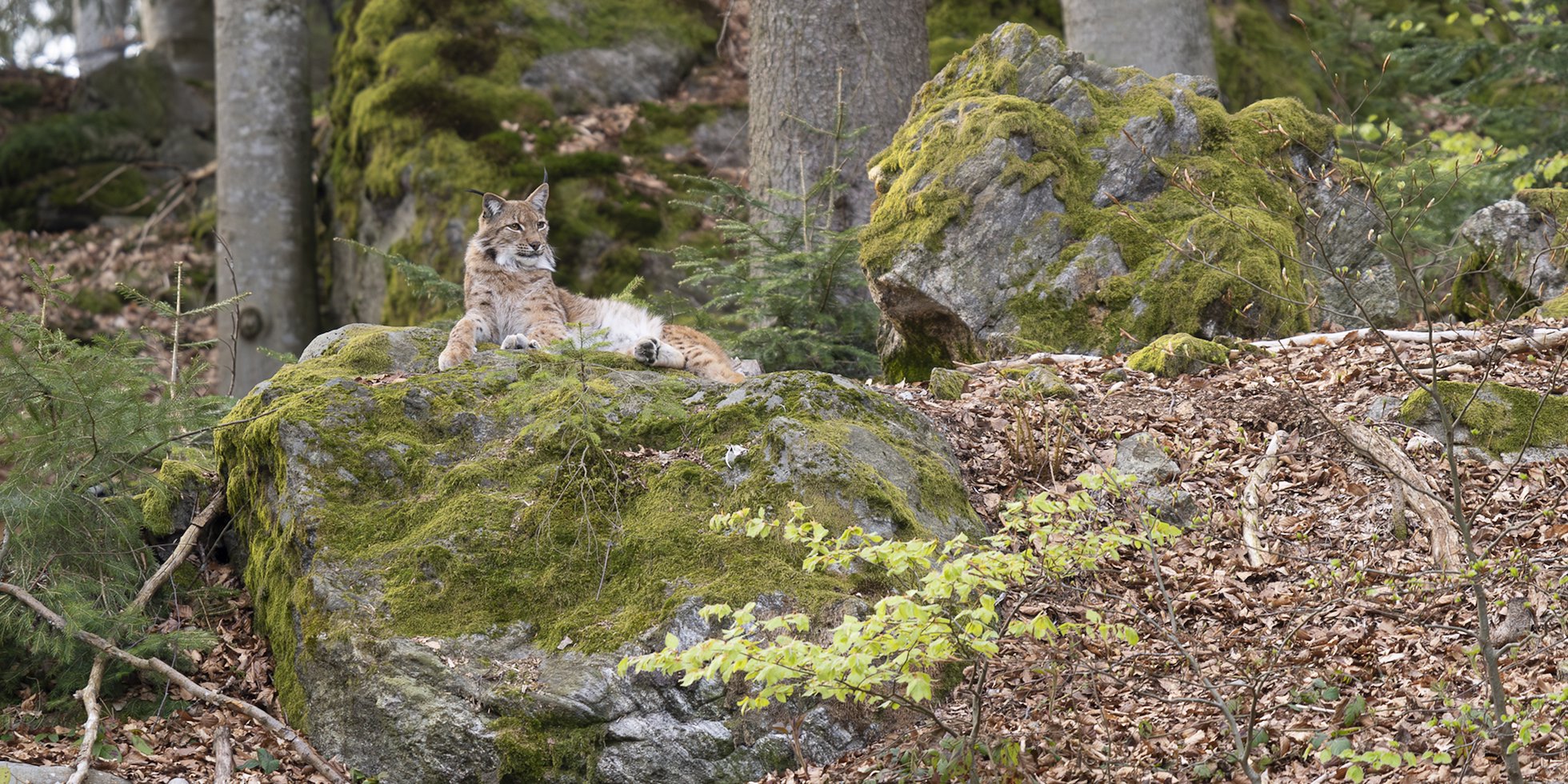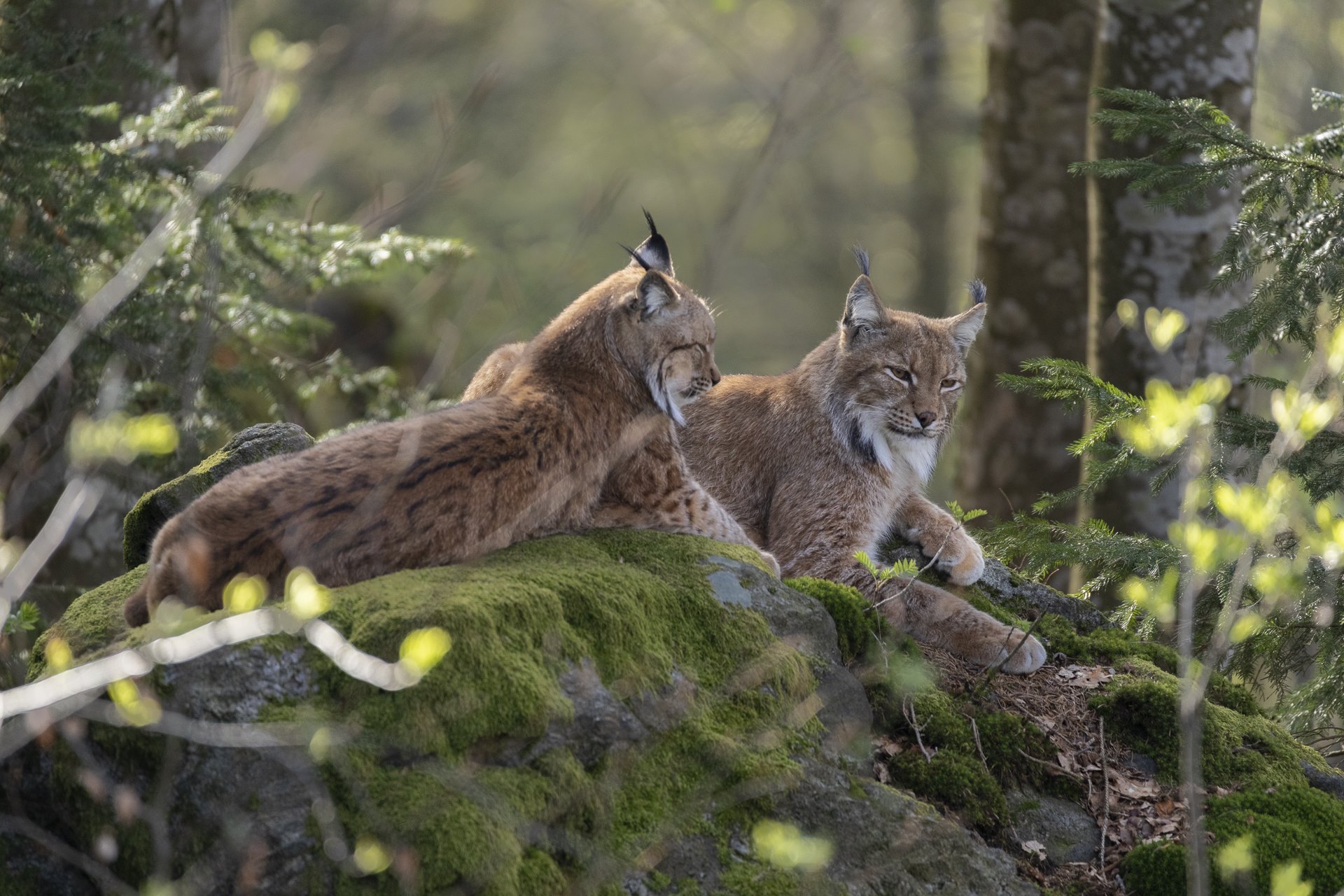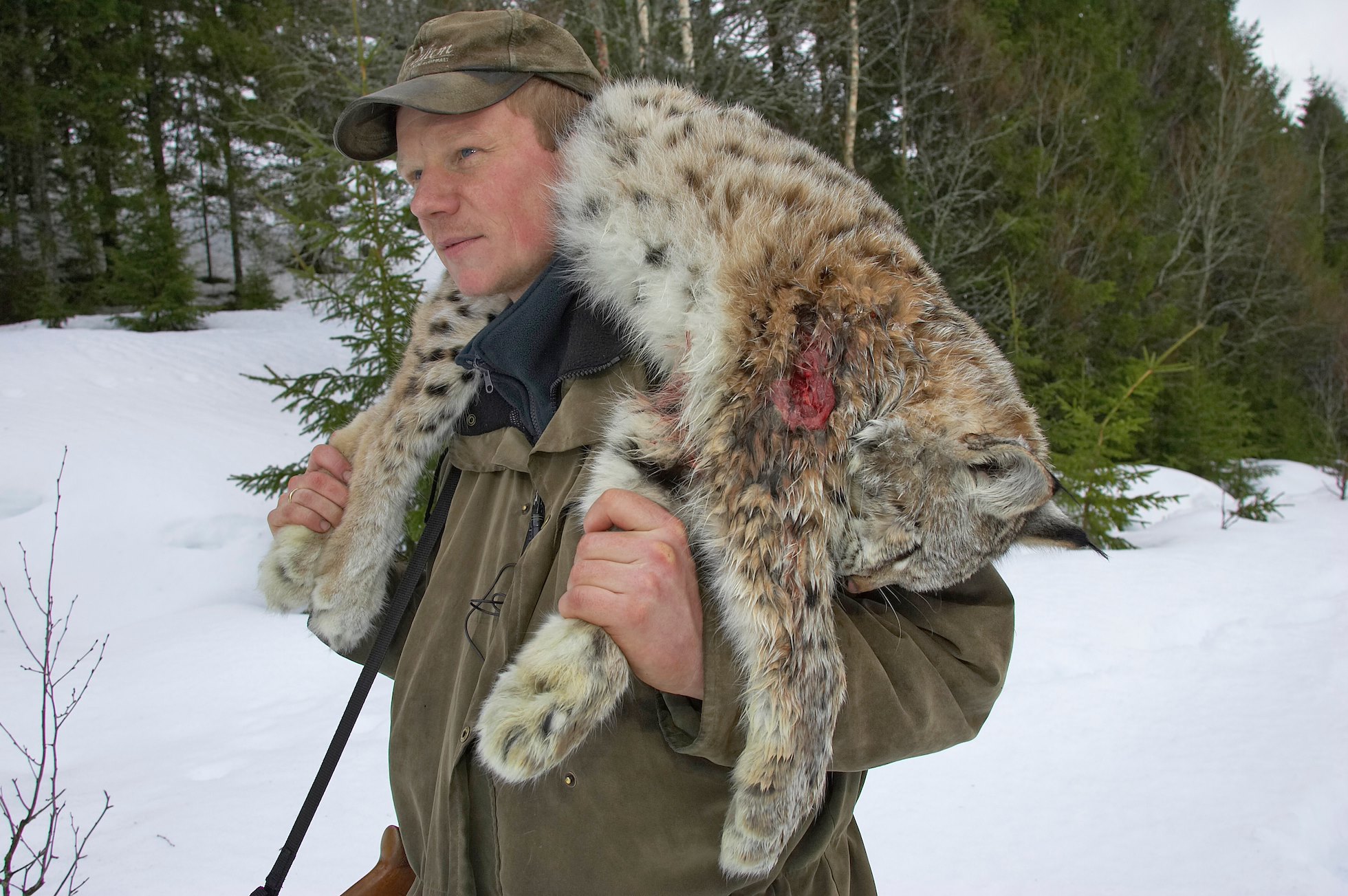Lynx With Slovenian Hunters
In Slovenia, hunters are helping conservationists to reinforce a critically threatened lynx population, recognising the lynx has a vital role to play in a healthy forest ecosystem.

Eurasian lynx, Lynx lynx, adult in beech forest in Bayerisher Wald National Park, Germany (Image taken in captivity)
The lynx picks his way down from the snow-clad ridge, following the rough track that cuts a scar through the forest. Stopping intermittently, inhaling scent in the frigid air, he recognises the signature of a territorial female. He can also smell humans – their strong scent lingering in the still night air, wreathed in the acrid tang of diesel and tobacco. Their smell is familiar though; foresters sometimes use an old cabin nearby, above the road leading to the local village in this corner of the Carpathian Mountains.
The lynx pauses where a fallen tree has blocked the track. He looks around, weighing up his options. The surrounding snow looks deep and wet, while a tunnel leads under the tangled vegetation, moonlight seeping in from the far end. He ventures in. The ground in the tunnel is lined with moss and leaves, but the air holds a trace of something more metallic. Unease tugs at him. One ear flicks irritably. He moves slowly forward but halfway through the tunnel, something snags his leg. Both ends of the tunnel slam shut and he is plunged into darkness.
Hardly daring to breathe, I lift the hatch that covers a spy hole and look inside.
“Michael, wake up!” urges Teresa. “The alarm has activated. We must go.” It’s probably the wildcat again, I think, as we trudge our way up the dark, snowy mountain in silence. But then, coming to the place where we had positioned the trap, a low belly growl makes the hair on the back of my neck stand on end. Hardly daring to breathe, I lift the hatch that covers a spy hole and look inside.
Rewind nearly half a century. It is the early 1970s and lynx have been missing from the Dinaric Alps of Slovenia and Croatia for 70 years, largely as a result of habitat loss, lack of prey and direct human persecution. Karl Weber, a Swiss national, is on a deer-hunting trip with friends in the forests of Kocevski Rog, when he becomes inspired to bring lynx back, feeling their missing presence as suddenly tangible.
Weber offered to fund a lynx reintroduction effort, and Slovenia’s forestry and hunting associations were receptive to the idea, reasoning that if their forests could not support a full range of native species, then they were not doing their job. So, in 1973, six lynx were captured in the mountains of what was then Czechoslovakia, and released in the forests of Kocevski Rog. The reintroduced lynx quickly spread beyond Slovenia, to Croatia in the south, Italy to the west, and Austria to the north, but problems were brewing.
The reintroduced lynx were soon heavily targeted by hunters, but this wasn’t the only problem. All six of the founding population were related to each other, including a mother and son, and a brother and sister. The population recovery slowed, halted and then finally went into reverse.
Hunters were to play a key role in the shifting fortunes of Slovenia’s lynx.
Assistant Professor Tomaž Skrbinšek of the University of Ljubljana observed this decline first-hand, recording cases where lynx had died from generalised sepsis. One young lynx had skeletal abnormalities associated with advanced age. It was apparent that the reintroduced lynx population was suffering chronic ill-health caused by isolation and inbreeding. There was a real danger of losing the lynx all over again, but hunters were to play a further key role in the shifting fortunes of Slovenia’s lynx.
The Hunting Association of Slovenia (HAS) is made up of hunting clubs known as families. Hunting may have contributed to historical declines, but lynx are no longer targeted in Slovenia. Srecko Žerjav, the current Director of HAS, explains that his association believes in a fully functioning ecosystem. He says: “If you want to have roe deer, if you want to have mouflon, or some other species, then lynx should be present, and allowed to have an influence.”
In early 2019, after two years of tracking and preparation, we captured our first lynx in Romania’s Carpathian Mountains. The vet, George, delivered a tranquiliser from a blowpipe. Minutes ticked by as we waited for the lynx to succumb to sedation. I had to remind myself to breathe. Finally, George gave the signal and we all set to work. We had caught a male lynx, around four years old, in perfect health. He was beautiful. Teresa, given the honour of naming him, chose the name Goru, after the highest peak in the region.
Funding from the European Union’s LIFE programme had started the ball rolling in 2017, when the LIFE Lynx project was launched to rescue Croatia’s and Slovenia’s declining lynx population. The aim was to introduce new genes from animals translocated from a healthy population in the Carpathian Mountains. More than a dozen organisations from Slovenia, Croatia, Italy, Slovakia and Romania, comprising hunters, foresters, scientists and conservationists were involved, all working together to bolster the lynx population in the Dinarics.
Maks Konecnik is now more than 90 years old but is still involved.
As with all predator translocations, success rested with fostering broad public support and here again, the hunting families have played an important role. Srecko Žerjav explains: “Farmers or locals with questions about wildlife, always ask hunters first.”
In Slovenia, hunters are increasingly involved in ecotourism. Dr Irena Kavcic, based at the University of Ljubljana, says hunters “know a lot about biology, wildlife and the landscape, and so often they are the ones who will take tourists into the forests. It really depends on each family and their interests, but now some hunting families have more guests looking for wildlife experiences than they have for hunting.”
To date, around 20 lynx have been captured in Romania and Slovakia, and released in either Croatia or Slovenia. Hunters have been involved throughout. One lynx was named Maks after the hunter Maks Konecnik who took care of the first lynx to be reintroduced back in 1973.
Maks Konecnik is now more than 90 years old but is still involved. He was present at the release of Goru. On 14 May 2019, the door to Goru’s enclosure was opened by Stanko Anzeljc, elder of the Loški potok hunting family. Stanko laughs as he describes the moment: “I did not expect that Goru would go out so fast, but I think when he saw freedom, the open space, he just went for it.”
While Goru had been held in quarantine, a female lynx, named Teja, was being monitored – via a satellite tracking collar – as part of an ongoing project to understand how the introduced animals were integrating themselves within the existing lynx population. Soon after Goru’s release, signals from his collar showed he was near a settlement called Mala Gora, in Teja’s territory.
Professor Skrbinšek shakes his head in disbelief as he recalls: “They even shared the same prey.” Nearly three months later, Teja was captured on a camera trap, with a kitten. The project’s goal of increasing genetic diversity had well and truly begun.

…the project is doomed without the continued support of hunters.
So, what does the future hold? Professor Skrbinšek says: “Long-term, this population is going to need connecting to others. This is why we are also releasing stepping-stone populations in the Julian Alps, between the Dinarics and the Alps.”
Collaboration with a broad range of stakeholders remains central to the recovery of the region’s lynx population. Rok Cerne is a forester and LIFE Lynx project coordinator. He believes the project is doomed without the continued support of hunters. In his view, “if they accept the lynx, then the lynx will stay in the forest. If not, then it will not stay.”

Hunter and recently shot lynx, Norway
Elsewhere in Europe, illegal killing by hunters has sometimes been a major cause of lynx mortality. Happily, the Hunting Association of Slovenia is already one step ahead, supporting the creation and training of a special lynx and wildlife crime police unit. They have “zero tolerance for illegal killing,” says Srecko Žerjav.
It seems that increasingly, Slovenia’s hunters recognise the lynx as a key ingredient of a healthy forest. It’s clear that there is no room for complacency, or for division, but Rok Cerne is happy with the way the project is progressing. “Before the project started, if I could’ve envisioned where we are now, then I would’ve been very happy,” he says. Lan Hocevar, a forester working on the LIFE Lynx project, is cautiously optimistic for the future. “For now, I don’t have any concerns, but that could change if there’s some drastic turnaround in politics and management.”
Goru was fitted with an updated collar in July 2020. Afterwards, Lan stayed nearby, to check on him. “It was a very intimate moment, just me and Goru under the stars,” says Lan. “My thoughts went back to winter 2019 in Romania, when we trapped him as the first lynx of the project, and how he truly succeeded and did what we hoped he would.”
As for me, since being involved with the LIFE lynx project, I have moved back to Scotland. I still often think about the Hunting Association of Slovenia, and their role in collaborating to ensure a brighter future for lynx in Slovenia. Here, in Scotland, the conversation around reintroducing lynx is gathering momentum, yet it remains unclear whether our hunting and shooting organisations will show Slovenian levels of enthusiasm for establishing apex predators within fully functioning ecosystems. I hope they do, but we will only find out by working together.
Michael Willett is an ecologist, now based in Scotland, who has worked on reintroduction and ecological restoration projects throughout Europe, with a special emphasis on wild European felids.
IS SCOTLAND READY FOR LYNX? FIND OUT MORE
GET YOUR FREE COPY OF ‘THE LYNX AND US’ USING DISCOUNT CODE SLOVLYNX
This feature is published on behalf of Lynx to Scotland, a partnership between Trees for Life, Lifescape and SCOTLAND: The Big Picture.


